What Is The Difference Between Pattern Bit And Flush Trim?
Pattern bits and flush trim bits are commonly used in woodworking to achieve precise and accurate cuts. While they are similar in some ways, there are distinct differences between the two that determine their specific applications. Let's explore the dissimilarities between pattern bits and flush trim bits:
- Function
- Cutting Direction
- Applications
- Cutting Surfaces
Pattern Bits: Pattern bits are primarily used for creating templates or duplicating intricate shapes. They are designed to follow a template or pattern and produce an identical shape in the workpiece. The cutting edges of pattern bits are typically located at the bottom of the bit.
Flush Trim Bits: Flush trim bits, as the name suggests, are used to trim or flush the edges of one material with another. They are commonly employed to remove excess material or to achieve a smooth, even surface. Flush trim bits have cutting edges positioned at the top or bottom of the bit.
Pattern Bits: Pattern bits typically cut in a downward direction. This means that the bit moves towards the workpiece, cutting the material as it moves along the template or pattern. The downward-cutting action ensures that the shape is accurately replicated in the workpiece.
Flush Trim Bits: Flush trim bits can cut in both upward and downward directions, depending on the desired outcome. When the cutting edges are positioned at the bottom, the bit moves in a downward direction. Conversely, if the cutting edges are located at the top, the bit moves in an upward direction. This versatility allows flush trim bits to be used in various trimming scenarios.
Pattern Bits: Pattern bits are commonly used in tasks such as making identical copies of curved or irregular shapes, replicating decorative designs, or producing multiples of a specific part. They are indispensable for creating complex and precise patterns in woodworking.
Flush Trim Bits: Flush trim bits excel at tasks that require trimming the edges of one material to match the contour or surface of another. They are frequently employed in tasks like trimming laminate, veneer, or edge banding, where achieving a seamless and flush finish is essential.
Pattern Bits: Pattern bits typically have cutting surfaces located at the bottom of the bit. This design allows the bit to follow the template or pattern accurately, resulting in a precise replication of the shape.
Flush Trim Bits: Flush trim bits can have cutting surfaces positioned at the top or bottom of the bit, depending on the specific design. When trimming the edges of a workpiece, the cutting edges of the flush trim bit remove excess material, ensuring a flush and even result.
In summary, pattern bits are primarily used for template routing and duplicating shapes, while flush trim bits are ideal for trimming or flushing edges. Pattern bits cut in a downward direction, following a template, while flush trim bits can cut in both upward and downward directions. Understanding the differences between these two types of router bits will help you choose the appropriate tool for your woodworking needs.

